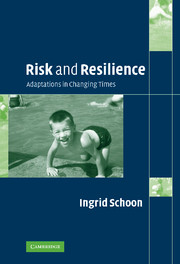Book contents
- Frontmatter
- Contents
- List of figures
- List of tables
- Foreword by Glen H. Elder, Jr
- Preface by John Bynner
- Acknowledgements
- Introduction
- 1 Risk and resilience: definitions
- 2 Towards a developmental-contextual systems model of adjustment
- 3 Persisting inequalities in times of social change
- 4 Selection, causation and cumulative risk effects
- 5 Protective factors and processes
- 6 Stability of early adjustment over time
- 7 Personal goals and life plans
- 8 Conclusions and outlook
- 9 Implications of findings for interventions and social policy
- Appendix A Two British birth cohorts
- Appendix B Response rates and handling of missing data
- Appendix C Description of variables used in the study
- References
- Index
Appendix C - Description of variables used in the study
Published online by Cambridge University Press: 22 September 2009
- Frontmatter
- Contents
- List of figures
- List of tables
- Foreword by Glen H. Elder, Jr
- Preface by John Bynner
- Acknowledgements
- Introduction
- 1 Risk and resilience: definitions
- 2 Towards a developmental-contextual systems model of adjustment
- 3 Persisting inequalities in times of social change
- 4 Selection, causation and cumulative risk effects
- 5 Protective factors and processes
- 6 Stability of early adjustment over time
- 7 Personal goals and life plans
- 8 Conclusions and outlook
- 9 Implications of findings for interventions and social policy
- Appendix A Two British birth cohorts
- Appendix B Response rates and handling of missing data
- Appendix C Description of variables used in the study
- References
- Index
Summary
MEASUREMENT OF VARIABLES USED IN ANALYSES
Indicators of social risk
Socio-economic disadvantage is indicated by parental social class and material conditions in the family household. The indicator variables are measured at ages seven, eleven and sixteen for NCDS and ages five, ten and sixteen for BCS70.
Parental social class in both cohorts is measured by the Registrar General's measure of Social Class (RGSC). The RGSC is defined according to job status and the associated education, prestige (OPCS, 1980) or life style (Marsh, 1986). It is assessed by the current or last held job, which is classified according to six ordinal categories. The definitions of social classes are adopted from the British census and include the following kinds of occupations:
Class I: Professionals and high-level managers and administrators
Class II: Intermediate professions including lower-level managers, technicians
Class IIInm: Clerks and other lower-level non-manual workers
Class IIIm: Skilled manual workers and foremen
Class IV: Semi-skilled non-manual, mainly service workers
ClassV: Unskilled workers
Class I represents the highest level of prestige or skill and class V the lowest (Leete & Fox, 1977). Professional status refers to occupations in medicine, law, etc., or senior civil servants. The intermediate group includes a wide range of white-collar jobs, including teaching, nursing and management, which are not professional, junior clerical or sales occupations. The occupational categories used in the US census and other European countries are similarly based on the skills and status of different occupations (Krieger et al., 1997).
Overcrowding. This is a dichotomous variable based on the ratio of people living in the household to the number of rooms in the household. […]
- Type
- Chapter
- Information
- Risk and ResilienceAdaptations in Changing Times, pp. 181 - 189Publisher: Cambridge University PressPrint publication year: 2006



